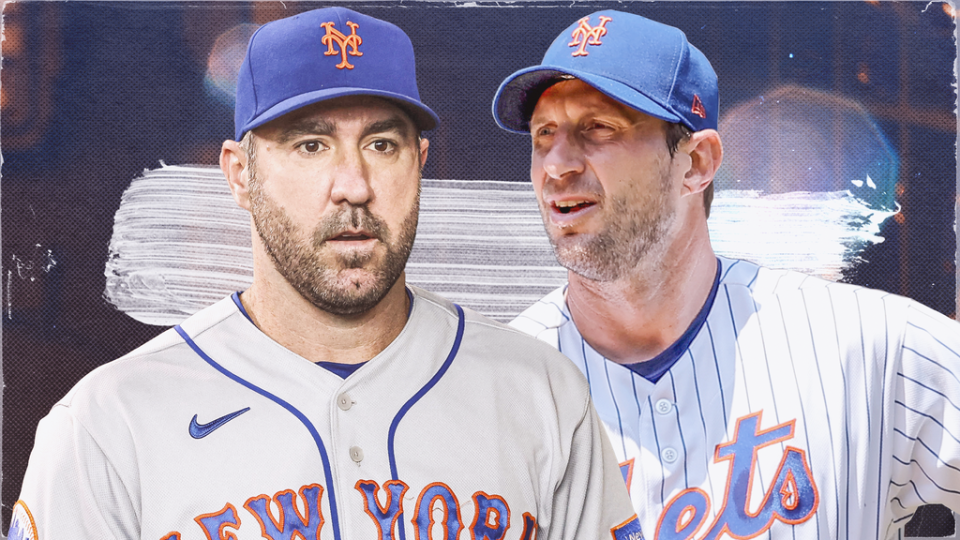
Let’s say for the sake of discussion that the Mets will trade Justin Verlander and Max Scherzer this month.
Here are two related questions that have flown under the radar in recent days: Who exactly would lead the starting rotation next season, when the team will presumably have similar championship aspirations?
And would replacing the two future Hall of Famers this winter lead the Mets to compromise their long-term future far more than they already have?
For all that has gone wrong with the 2023 Mets, one aspect of the team’s strategy continues to look very wise: The aversion to long-term free agent contracts for starting pitchers.
Verlander and Scherzer have underperformed, but the brevity of their contracts (two years plus a player opt-in for Scherzer; two years plus a vesting option for Verlander) means that their declines will not hamstring the Mets for long.
For all their spending last offseason, Brandon Nimmo‘s eight-year deal was the only Mets contract of an irrational length.
The team stood back with no small measure of relief and watched the Texas Rangers offer Jacob deGrom five years, and the Yankees offer Carlos Rodon six. DeGrom has undergone Tommy John surgery since then; Rodon recently made his debut season, and could yet become a Yankee champion — but so far, Verlander has been the most productive of the trio in 2023, with the added benefit of being a short-timer.
Without Verlander and Scherzer, the Mets would have Kodai Senga, Jose Quintana, David Peterson and Taylor Megill as their top four options for next year’s rotation. They will obviously add to that, but it will be tricky to do so without introducing the type of long-term risk that they have so far avoided.
The top free agent starters for next year are Shohei Ohtani, Blake Snell and Julio Urias. Snell, 30, is the oldest of that trio — and any free agent ace at age 30 or younger can reasonably expect a five-, six- or seven-year contract (and, while this isn’t an Ohtani column, suffice it to say that we can’t find anyone in baseball who believes Ohtani will sign in New York).
Before the Mets trade Verlander or Scherzer, the front office will have to generate projections of what Urias and Snell will look like not only in 2024, but in 2025, 2026, 2027, and beyond. Is it really a better bet to give a young ace seven years than it is to give an aging ace three years?
In some cases, sure. In many cases, no way.
Another highly intriguing rotation option for the Mets next year and beyond will be Nippon Professional Baseball ace Yoshinobu Yamamotowho is just 24 years old.
An evaluator familiar with Yamamoto described him as “Chris Bassitt with more velo,” meaning that he has a wide repertoire of pitches like the resourceful Bassitt, but a firmer fastball. That evaluator projected Yamamoto as a No. 2 starter, or a No. 3 on a championship team.
Unlike Senga, evaluators do not speculate that Yamamoto will end up in the bullpen. Because of that, he will probably earn significantly more than the five years, $75 million that the Mets gave Senga last September.
Mets general manager Billy Eppler has already traveled to Japan this year to watch Yamamoto. As was the case with Senga, Eppler’s deep connections and credibility in that country could help give the Mets an advantage in Yamamoto’s free agency.
Elsewhere in free agency, there will be plenty of other starters for the Mets to explore, from Lucas Giolito to Eduardo Rodriguez (who has an opt-out) to Aaron Nola to Jack Flaherty to Luis Severino to Frankie Montas to Tyler Mahle to James Paxton to Alex Cobb.
Each of those players brings his own combination of upside and risk, and one or two of them could make for a nice short-term play. But none projects as the ace of a team playing in the 2024 World Series.
We’re not saying that the current versions of Scherzer and Verlander do, either. But for the long-term health of the Mets, the team has to be sure before asking either to waive his no-trade clause that replacing them won’t leave the organization in an even worse place.